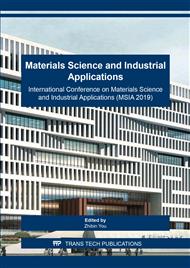[1]
E. Troiani, M. P. Falaschetti, S. Taddia, and A. Ceruti, CFRP Crash Absorbers in Small UAV: Design and Optimization,, SAE Technical Paper 0148-7191, (2015).
DOI: 10.4271/2015-01-2461
Google Scholar
[2]
N. Yidris, Crash simulation of a composite unmanned aerial vehicle fuselage,, Universiti Putra Malaysia, (2007).
Google Scholar
[3]
T. Singhanart, C. Srimontok, N. Pisitpan, S. Chitimaworaphan, and W. Mongkhonchaiwiwat, Design and analysis of UAV fuselage,, in Applied Mechanics and Materials, 2012, pp.305-309.
DOI: 10.4028/www.scientific.net/amm.225.305
Google Scholar
[4]
S. V. Mahantayya KHiremath, Crash Analysis of Unmanned Aerial Vehicle Using FEA , International Journal of Innovative Research in Science, Engineering and Technology, vol. Vol. 5, (2016).
Google Scholar
[5]
N. Yidris, R. Zahari, D. Majid, F. Mustapha, M. Sultan, and A. Rafie, Crush simulation of woven c-glass/epoxy unmanned ariel vehicle fuselage section,, International Journal of Mechanical and Materials Engineering, vol. 5, pp.260-267, (2010).
Google Scholar
[6]
P. Leomar, M. Tamre, T. Riibe, T. Vaher, and T. Haggi, Optimal design and analysis of UAV swan fuselage,, in Solid State Phenomena, 2006, pp.91-96.
DOI: 10.4028/www.scientific.net/ssp.113.91
Google Scholar
[7]
F. Manual, ANSYS, Release 15.0 ANSYS Documentation. ANSYS Inc, Canonsburg, PA,,, ed, (2013).
DOI: 10.1016/b978-0-12-811768-2.00022-5
Google Scholar
[8]
M. zahran, UAV Structure Improvement for Protection of Critical System,, (2017).
Google Scholar
[9]
R. N. Jazar and L. Dai, Nonlinear Approaches in Engineering Applications: Advanced Analysis of Vehicle Related Technologies: Springer, (2016).
Google Scholar
[10]
L. Dai and L. Dai, Nonlinear Approaches in Engineering Applications: Springer New York, (2012).
Google Scholar
[11]
T. Belytschko, J. I. Lin, and T. Chen-Shyh, Explicit algorithms for the nonlinear dynamics of shells,, Computer methods in applied mechanics and engineering, vol. 42, pp.225-251, (1984).
DOI: 10.1016/0045-7825(84)90026-4
Google Scholar
[12]
H. C. Kim, D. K. Shin, J. J. Lee, and J. B. Kwon, Crashworthiness of aluminum/CFRP square hollow section beam under axial impact loading for crash box application,, Composite Structures, vol. 112, pp.1-10, (2014).
DOI: 10.1016/j.compstruct.2014.01.042
Google Scholar
[13]
P. F. Liu and J. Zheng, Progressive failure analysis of carbon fiber/epoxy composite laminates using continuum damage mechanics,, Materials Science and Engineering: A, vol. 485, pp.711-717, (2008).
DOI: 10.1016/j.msea.2008.02.023
Google Scholar
[14]
M. Esa, P. Xue, M. Zahran, M. Abdelwahab, and M. Khalil, Novel strategy using crash tubes adaptor for damage levels manipulation and total weight reduction,, Thin-Walled Structures, vol. 111, pp.176-188, (2017).
DOI: 10.1016/j.tws.2016.11.018
Google Scholar
[15]
Q.-Q. S. D.-N. Zhang, C.-J. Xie, F. Liu, A modified Johnson Cook model of dynamic tensile behaviors for 7075-T6 aluminum alloy,, Journal of Alloys and Compounds, vol. 619, pp.186-194, (2015).
DOI: 10.1016/j.jallcom.2014.09.002
Google Scholar
[16]
L. A. Marcus Menchawi, Modeling of fiberglass reinforced epoxy composites in LS-DYNA. Linköping University, (2014).
Google Scholar
[17]
B. Simhachalam, K. Srinivas, and C. L. Rao, Energy absorption characteristics of aluminium alloy AA7XXX and AA6061 tubes subjected to static and dynamic axial load,, International Journal of Crashworthiness, vol. 19, pp.139-152, (2014).
DOI: 10.1080/13588265.2013.878974
Google Scholar
[18]
D. Siromani, Crashworthy design and analysis of aircraft structures: Drexel University, (2013).
Google Scholar
[19]
S. G. Gupta, M. M. Ghonge, and P. Jawandhiya, Review of unmanned aircraft system (UAS),, technology, vol. 2, (2013).
DOI: 10.2139/ssrn.3451039
Google Scholar
[20]
P. Fahlstrom and T. Gleason, Introduction to UAV systems: John Wiley & Sons, (2012).
Google Scholar
[21]
J. Gundlach, Designing unmanned aircraft systems: A comprehensive approach: American Institute of Aeronautics and Astronautics, (2012).
Google Scholar
[22]
R. Austin, Unmanned aircraft systems: UAVS design, development and deployment vol. 54: John Wiley & Sons, (2011).
Google Scholar


